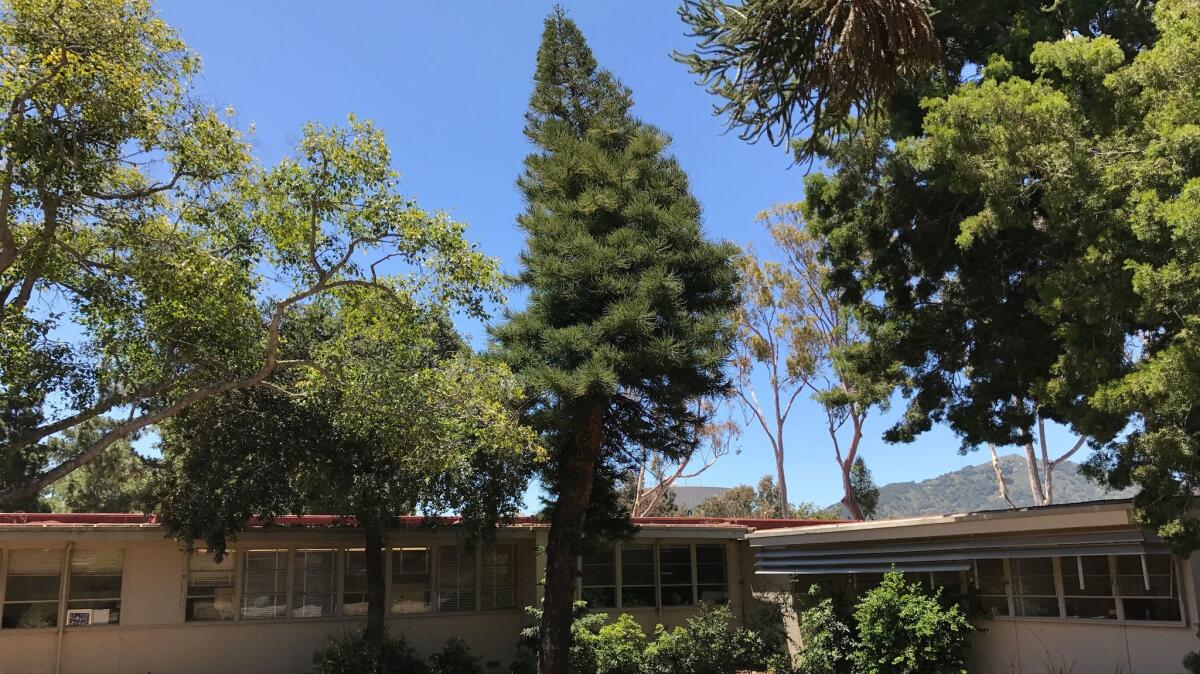California Journal: The case of the leaning pine tree: A natural history mystery unfolds on the Central Coast
- Share via
Reporting from San Luis Obispo — Like a lot of trees on the Cal Poly campus here, the Cook pine was tall and beautiful but not especially remarkable.
At least not at first glance.
For the record:
2:40 p.m. June 18, 2017The lead image on an earlier version of this report was mistakenly distorted.
But as Matt Ritter and I got a little closer, it became obvious that there was something odd about this tree. It was bent. It actually bowed slightly toward the south.
Not only that, but Ritter, a Cal Poly biology professor, has recently discovered that all Cook pines, which are native to New Caledonia, a blip in the South Pacific, lean toward the equator no matter where they grow.
“This has never before been seen in plants,” said Ritter, 42, a botanist who specializes in trees. But once he started looking at Cook pines, he saw them leaning everywhere, he said.
“And I thought, you know, that’s weird. No trees lean to the south. It doesn’t make sense.”

He called a colleague in Australia, an arborist named Dean Nicolle, and asked whether Nicolle had noticed the leaning pines. Indeed, he had. In Australia, Nicolle said, they always lean north.
“That was my ‘aha’ moment,” Ritter said. “Is it possible they all could be leaning toward the equator?”
Two hundred fifty-six Cook pines on five continents later, Ritter had an answer: Yes.
In a paper published in the science journal Ecology, Ritter and three co-authors (including Nicolle) announced that they had identified “a novel hemisphere-dependent leaning habit.” Not only that, the scientists also discovered that the further a Cook pine gets from the equator, the more pronounced its list.
This natural history mystery has ignited the interest and imaginations of people around the world.
“The amount of attention that we have gotten is amazing,” said Ritter, sitting in his second-floor office, which has curved walls and feels, come to think of it, a bit like a treehouse. “There’s an Italian article about me that I don’t even understand.”
There are, of course, theories about why Cook pines lean. But before I tell you about them, and about how the tree got here, allow me to digress for a moment about California trees in general, and the eucalyptus in particular, because Ritter knows more about the eucalyptus than just about anyone.
::
When I walked into Ritter’s office, I was holding a copy of “Trees in Paradise,” a remarkable 2013 book about four iconic California trees by historian Jared Farmer.
Farmer examines the palm, the orange, the redwood and the eucalyptus. Of those, the redwood is the true native. (Well, and one kind of palm — the California fan palm.) The others were imported for industry, agriculture or aesthetics. But like so many immigrants who have put down roots in California, they may as well be considered as native as the coast live oak.
Not all tree lovers feel that way. A couple of years ago, Ritter told me, he invited Farmer to give a talk about eucalyptus to a gathering of the California Native Plant Society.
“Eucalyptus,” Ritter said, “is the most controversial plant in California.”

Apparently things got a little heated. Some of the more ardent fans of native California plants were not willing to concede that the eucalyptus, technically an interloper, has earned a solid place in the cultural history of California.
“People booed him,” Ritter said. “It was awesome.”
In some ways, the eucalyptus is a perfect example of the California get-rich-quick mindset. It was imported from Australia in great numbers after the Gold Rush, when oaks and redwoods were being decimated for fuel and construction.
“You have to remember, this was pre-fossil fuel,” Ritter said. “Everybody thought there was going to be this timber drought in California. So this tree came from Australia — this miracle — this fast-growing tree that was going to save everyone. You could plant it on your least arable land. But fast-growing trees and good wood tend to be inversely proportional. It was a bad idea.”
The eucalyptus is disliked for many reasons, and not just because it falls over in high winds. (Native oaks, as it happens, tip over or lose branches more often than eucalyptus, according to the California Tree Failure Report.) The tree, which produces a great deal of leaf and bark debris, was blamed for exacerbating the catastrophic 1991 Berkeley Hills fire.
“Local newspapers portrayed eucalyptus as murderous and villainous,” wrote Farmer, “the story of the California Dream gone awry.”
That rap seems a bit over the top.
“They’re beautiful trees,” said Ritter, who has written a nifty book called “A Californian’s Guide to the Trees Among Us.” “They grow where other trees will not, and they are part of our California natural history, whether you like it or not.”
Now, about those listing pines.
::
Cook pines arrived in California via Hawaii after they were discovered in New Caledonia by Capt. James Cook, the 18th-century British explorer and navigator. He brought seeds to Hawaii, where they are propagated to this day.
“They only come to California through this weird nursery trade from Hawaii,” Ritter said. “People buy them at Christmastime as little plants in red tinfoil — they’re often called star pines. Then they get too big and people plant them in their yards.”
It’s possible that Cook accidentally selected only leaning trees, thus creating what botanists call “a genetic bottleneck.” That notion will be tested in a Cal Poly lab, where genetics from the wild population will be compared with Cook pines from around the world.
Or perhaps the trees are responding to some kind of force — magnetism, or some as-yet-unidentified annual incidence of light. Maybe the leaning has to do with the Coriolis effect, which is why water swirls in different directions in the Northern and Southern hemispheres.
Maybe the tendency to lean has something to do with the way certain spinning enzymes react to the various forces.
When I mentioned to Ritter that some laymen have theorized the Cook pine simply wants to go home, he just looked at me like the pathetic non-scientist that I am.
“Plants don’t want anything,” he said. “They have no central nervous system. They have no purpose or intention.”
And yet, they demand that their mysteries be solved.
Twitter: @AbcarianLAT
ALSO
Big Sur is once again coping with natural disaster and looming economic catastrophe
You probably don’t see the dredge in Marina del Rey, but it’s going to make your summer better







